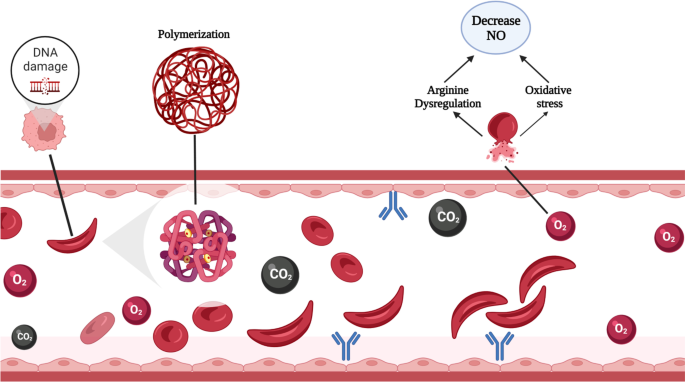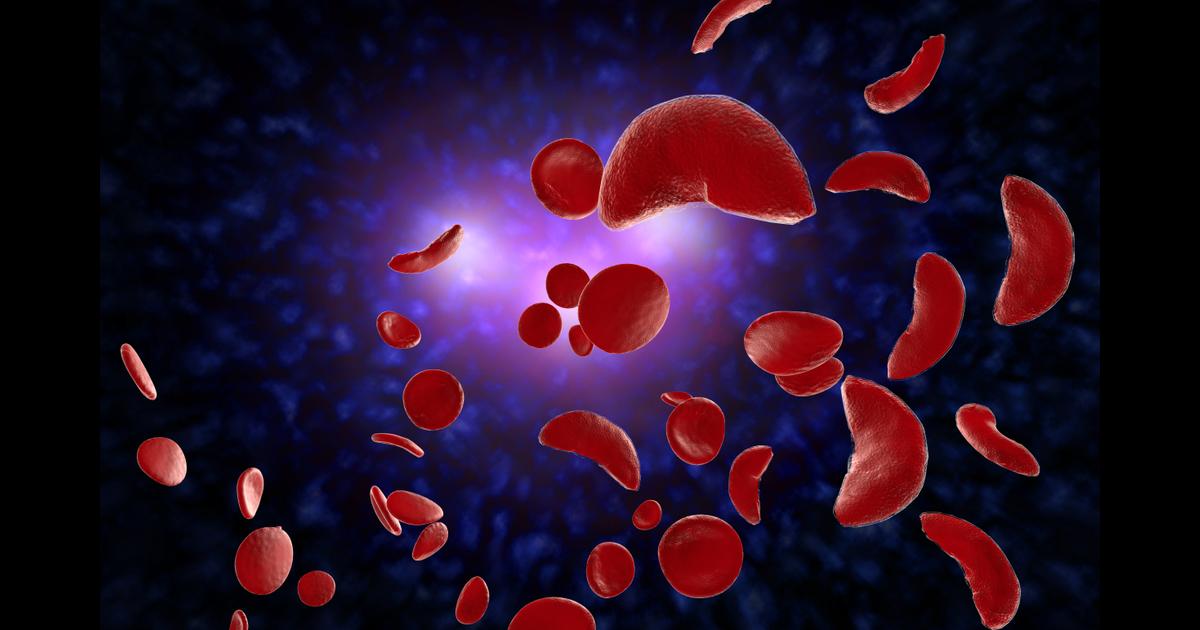Living with sickle-cell anemia is a constant battle against pain, complications, and the search for effective treatments. As science progresses, hope flickers on the horizon with new therapeutic options promising to enhance the quality of life for those affected.
In this blog post, we delve into the latest treatments, including an intriguing development involving medical marijuana, providing a beacon of hope and practical advice for those navigating this challenging condition.
This condition affects not only the physical body but also the emotional and social lives of patients and their families. As we explore these groundbreaking treatments, we also recognize the resilience of those who live with this disease every day. Our goal is to provide insights that can lead to better management and possibly a brighter future for patients.
Understanding Sickle-cell Anemia
 At its core, sickle-cell anemia stems from a genetic glitch that causes hemoglobin—the oxygen-carrying component of red blood cells—to become abnormal. This defect makes the red blood cells rigid and shaped like a sickle, leading to blockages in blood flow, severe pain, infections, and organ damage. What does this mean for daily life?
At its core, sickle-cell anemia stems from a genetic glitch that causes hemoglobin—the oxygen-carrying component of red blood cells—to become abnormal. This defect makes the red blood cells rigid and shaped like a sickle, leading to blockages in blood flow, severe pain, infections, and organ damage. What does this mean for daily life?
The impact can range from simple fatigue to debilitating pain crises without any warning. Each symptom presents a hurdle, but understanding this condition is the first step towards effective management. Patients often describe pain as the most immediate and severe symptom, striking unpredictably and varying in intensity.
Moreover, complications like acute chest syndrome and heightened infection risks compound the daily challenges faced. Early detection and proactive treatment are critical in staving off these severe complications.
Educating those affected about potential symptoms fosters better outcomes and empowers individuals to manage their condition effectively. This knowledge not only helps in immediate treatment but also aids in planning for potential complications, providing a roadmap for long-term care.
Current Treatments for Sickle-cell Anemia
Treatment historically revolves around symptom management and crisis prevention. Hydroxyurea, a frontline medication, reduces the occurrence of pain episodes and acute chest syndrome. Regular blood transfusions supplement this by diluting abnormal blood cells with healthy ones, preventing further complications. But how does this translate into everyday life?
 Regular check-ups are crucial for tailoring treatment plans and preventing serious complications. Newer medications like Endari have broadened the options available, helping those with frequent pain episodes. The evolving treatment landscape now includes holistic care teams, emphasizing not just medical treatment but also lifestyle advice and psychological support.
Regular check-ups are crucial for tailoring treatment plans and preventing serious complications. Newer medications like Endari have broadened the options available, helping those with frequent pain episodes. The evolving treatment landscape now includes holistic care teams, emphasizing not just medical treatment but also lifestyle advice and psychological support.
Regular exercise, hydration, and diet adjustments play supportive roles, enhancing treatment effectiveness and daily quality of life. The integration of these treatments requires careful coordination by healthcare professionals to ensure that each patient’s unique needs are met.
Patients are encouraged to stay informed about new treatments and discuss these options with their healthcare providers, fostering a proactive approach to managing their health.
Advances in Gene Therapy
Gene therapy is breaking new ground, offering not just management but potential cures for sickle-cell anemia. Techniques like CRISPR to target and correct the genetic errors directly, showcasing a revolutionary approach to treatment. What does this mean for patients?
The possibility of a life free from the disease’s symptoms. Trials show promising results, indicating a shift from managing symptoms to potentially curing the condition altogether.
The potential of gene therapy goes beyond symptom treatment; it hints at eradicating the disease. Ongoing research is crucial as it navigates the safety and effectiveness of these therapies, aiming to make them accessible to all.
Researchers are also exploring how to boost fetal hemoglobin production, which could prevent red blood cells from sickling and improve oxygen transport. The excitement around these advances is palpable, as they offer a glimpse into a future where genetic disorders like sickle-cell anemia can be treated at their source.
The collaboration between researchers, clinicians, and patients is essential in advancing these therapies from the laboratory to the clinic. With each successful trial, the dream of curing sickle-cell anemia inches closer to reality, fueling the hope of millions.
The Role of Medical Marijuana in Managing Pain
Chronic pain is one of the most excruciating aspects of sickle-cell anemia, often poorly managed by traditional painkillers. Medical marijuana has come to the forefront as a powerful tool for pain management, noted for its ability to ease chronic pain where other medications fail. But how does it work? Cannabinoids in marijuana may interact with pain receptors in the brain to reduce pain sensation and inflammation.
This treatment offers a potentially more effective and safer alternative for managing pain, especially for those who suffer from frequent pain crises or have issues with opioids.
The clinical community is increasingly recognizing the benefits of medical marijuana, reflected in changing laws and growing patient access. This development promises a less harmful, more effective approach to pain management, empowering patients with new choices.
 Patient testimonials and ongoing research suggest that medical marijuana could significantly improve the quality of life for those with chronic pain, making it a key component of pain management strategies in sickle-cell anemia. As this area of medicine evolves, it is important for patients to maintain open communication with their healthcare providers to tailor treatments to their specific needs and circumstances.
Patient testimonials and ongoing research suggest that medical marijuana could significantly improve the quality of life for those with chronic pain, making it a key component of pain management strategies in sickle-cell anemia. As this area of medicine evolves, it is important for patients to maintain open communication with their healthcare providers to tailor treatments to their specific needs and circumstances.
For those in Mississippi living with sickle-cell anemia, medical marijuana has become an accessible treatment option. The state recognizes the disease as a qualifying condition for cannabis use. How can residents get started? It begins with a conversation with licensed medical marijuana doctors in Mississippi who evaluate if cannabis is a suitable treatment.
These specialists guide patients through the process of obtaining a medical marijuana card, ensuring treatments are safe and legally compliant. This card opens the door to a range of cannabis products, allowing for tailored treatments that address individual symptoms and preferences.
The ongoing collection of patient experiences will help refine treatment protocols, enhancing the effectiveness of medical marijuana for managing sickle-cell pain. The relief that medical marijuana provides can be life-changing, offering respite from the relentless pain that characterizes sickle-cell anemia.
As more states recognize the therapeutic benefits of cannabis, it is hoped that more patients across the country will gain access to this effective treatment option.
Lifestyle and Supportive Care
Beyond medications, lifestyle changes and supportive care are fundamental in managing sickle-cell anemia. A diet rich in folic acid, adequate hydration, and regular exercise can mitigate symptoms and boost overall health.
Emotional and psychological support are equally important. Support groups and mental health counseling can alleviate the emotional strain of living with a chronic illness. Small lifestyle tweaks can significantly impact overall well-being.
Furthermore, families and caregivers also benefit from support and resources, helping them provide the best care possible. The goal is to create a nurturing environment that supports not just physical health, but also emotional and psychological well-being, promoting a holistic approach to disease management.
Building a supportive community around sickle-cell patients can provide a much-needed sense of belonging and understanding, helping to navigate the emotional ups and downs of the disease.
Encouraging patient engagement and active participation in treatment decisions can significantly enhance the effectiveness of care plans, making daily management more sustainable.
Conclusion
The journey through the landscape of sickle-cell anemia treatment is evolving rapidly, with each new therapy offering hope and potential transformation for those affected.
This is an exciting time in medical research, and ongoing patient advocacy and research are key to a hopeful future. The resilience and strength shown by those who live with this disease inspire continued efforts to improve care and treatment options.





